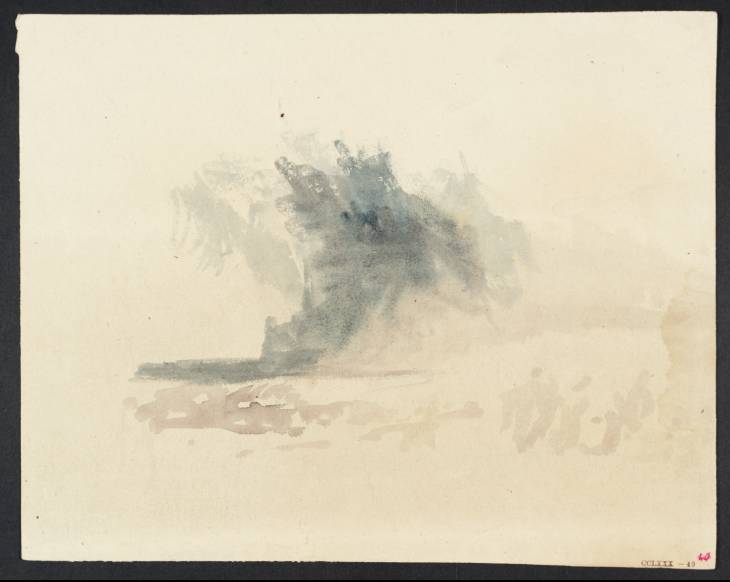Joseph Mallord William Turner Vignette Study for Campbell's 'Poetical Works'; for ?'O'Connor's Child' or 'Lord Ullin's Daughter' c.1835-6
Joseph Mallord William Turner,
Vignette Study for Campbell's 'Poetical Works'; for ?'O'Connor's Child' or 'Lord Ullin's Daughter'
c.1835-6
Joseph Mallord William Turner 1775–1851
Vignette Study for Campbell’s ‘Poetical Works’; for ?‘O’Connor’s Child’ or ‘Lord Ullin’s Daughter’ circa 1835–6
D27557
Turner Bequest CCLXXX 40
Turner Bequest CCLXXX 40
Watercolour, approximately 115 x 195 mm on off-white machine-made cartridge paper paper, 179 x 226 mm
Inscribed by John Ruskin in red ink ‘40’ bottom right
Stamped in black ‘CCLXXX 40’ bottom right
Inscribed by John Ruskin in red ink ‘40’ bottom right
Stamped in black ‘CCLXXX 40’ bottom right
Accepted by the nation as part of the Turner Bequest 1856
References
1909
A.J. Finberg, A Complete Inventory of the Drawings in the Turner Bequest, London 1909, vol.II, p.894, as ‘Possibly for Campbell’s Poems’.
1993
Jan Piggott, Turner’s Vignettes, exhibition catalogue, Tate Gallery, London 1993, p.95.
1999
Peter Bower, Turner’s Later Papers: A Study of the Manufacture, Selection and Use of his Drawing Papers 1820–1851, exhibition catalogue, Tate Gallery, London 1999, p.59.
This work is one of a group of more than thirty watercolour sketches in the Turner Bequest that appear to be preparatory studies for Campbell’s Poetical Works. They are all painted on cheap, lightweight paper and executed in a rough, loose style. Although the content is too vague to be firmly linked to any of the finished vignettes in the series, the tempestuous seascape, gathering storm and the figurative group in the right-hand corner suggest that it may be an early design for one of two illustrations: Lord Ullin’s Daughter, or O’Connor’s Child.
Campbell’s poem ‘Lord Ullin’s Daughter’, is a tragic tale of a heroine who drowns at sea during an attempt to elope with her secret lover. Turner’s finished watercolour (National Gallery of Scotland),1 depicts the ill-fated couple awaiting the ferry that will take them to their deaths, and this may also be the configuration represented in the study. In particular, the storm clouds amassing in the sky may reflect the following lines:
“O haste, thee haste!” the lady cries,
“Though tempests round us gather;
I’ll meet the raging of the skies;
But not an angry father.”
“Though tempests round us gather;
I’ll meet the raging of the skies;
But not an angry father.”
The boat has left a stormy land,
A stormy sea before her, –
When oh! too strong for human hand
The tempest gathered o’er her.
(Poetical Works of Thomas Campbell, 1837, p.94)
A stormy sea before her, –
When oh! too strong for human hand
The tempest gathered o’er her.
(Poetical Works of Thomas Campbell, 1837, p.94)
An alternative connection is that the study represents an early concept for an illustration to Campbell’s poem ‘O’Connor’s Child’. This too features a doomed relationship between the daughter of an Irish chieftain and her ‘basely born’ lover who is murdered by her brothers. Like other studies related to Turner’s final design and to the spirit of Campbell’s verse, the sombre, lonely seascape scene recalls the following lines:
Why lingers she from Erin’s host,
So far on Galway’s shipwreck’d coast;
Why wanders she a huntress wild –
O’Connor’s pale and lovely child?
(Poetical Works of Thomas Campbell, 1837, p.68)
So far on Galway’s shipwreck’d coast;
Why wanders she a huntress wild –
O’Connor’s pale and lovely child?
(Poetical Works of Thomas Campbell, 1837, p.68)
Five other vignette studies may also relate to O’Connor’s Child. One of them shows the heroine and her lover just before they are captured by her murderous brothers (Tate D27575; Turner Bequest CCLXXX 58), and three others may be variations on the study seen here (see Tate D27557, D27574 and D27576; Turner Bequest CCLXXX 40, and 57, 59).
The work was once part of a parcel of studies described by John Ruskin as ‘A.B. 40. PO. Vignette beginnings, once on a roll. Worthless’.2 For an explanation of his meaning of ‘once on a roll’ see the technical notes above. Finberg records how Ruskin later described his phrasing in a letter to Ralph Nicholson Wornum as ‘horrible’, adding ‘I never meant it to be permanent’.3
Technical notes:
Peter Bower has noted that this study is made on off-white low-grade machine-made cartridge paper. The maker is unknown and there is no watermark. This paper would have been relatively cheap to buy and could have been purchased from a colourman, cut off from a roll to the desired size. Turner has used the ‘felt’ side of the paper which has slightly more texture than the ‘wire’ side, allowing better adhesion of pigment and graphite to the surface of the sheet. Many of Turner’s vignette studies were made on a similar grade of machine-made paper, and the artist employed the ‘felt’ side on all of them.1
Peter Bower has noted that this study is made on off-white low-grade machine-made cartridge paper. The maker is unknown and there is no watermark. This paper would have been relatively cheap to buy and could have been purchased from a colourman, cut off from a roll to the desired size. Turner has used the ‘felt’ side of the paper which has slightly more texture than the ‘wire’ side, allowing better adhesion of pigment and graphite to the surface of the sheet. Many of Turner’s vignette studies were made on a similar grade of machine-made paper, and the artist employed the ‘felt’ side on all of them.1
Verso:
Inscribed by unknown hands in pencil ‘AB 40 P | O’ bottom right
Meredith Gamer
August 2006
How to cite
Meredith Gamer, ‘Vignette Study for Campbell’s ‘Poetical Works’; for ?‘O’Connor’s Child’ or ‘Lord Ullin’s Daughter’ c.1835–6 by Joseph Mallord William Turner’, catalogue entry, August 2006, in David Blayney Brown (ed.), J.M.W. Turner: Sketchbooks, Drawings and Watercolours, Tate Research Publication, December 2012, https://www

